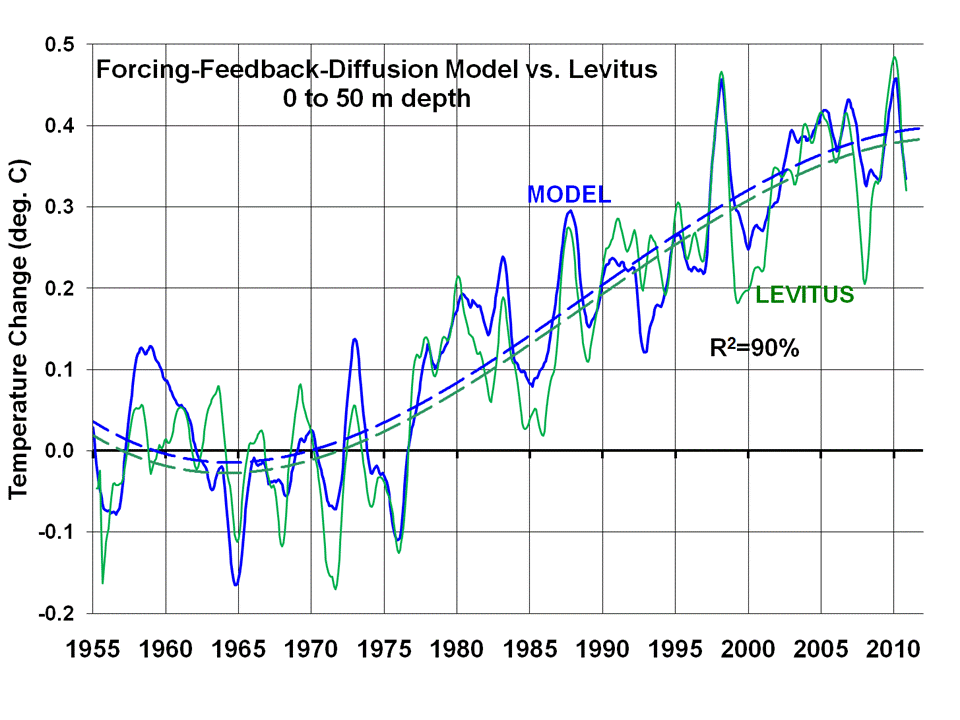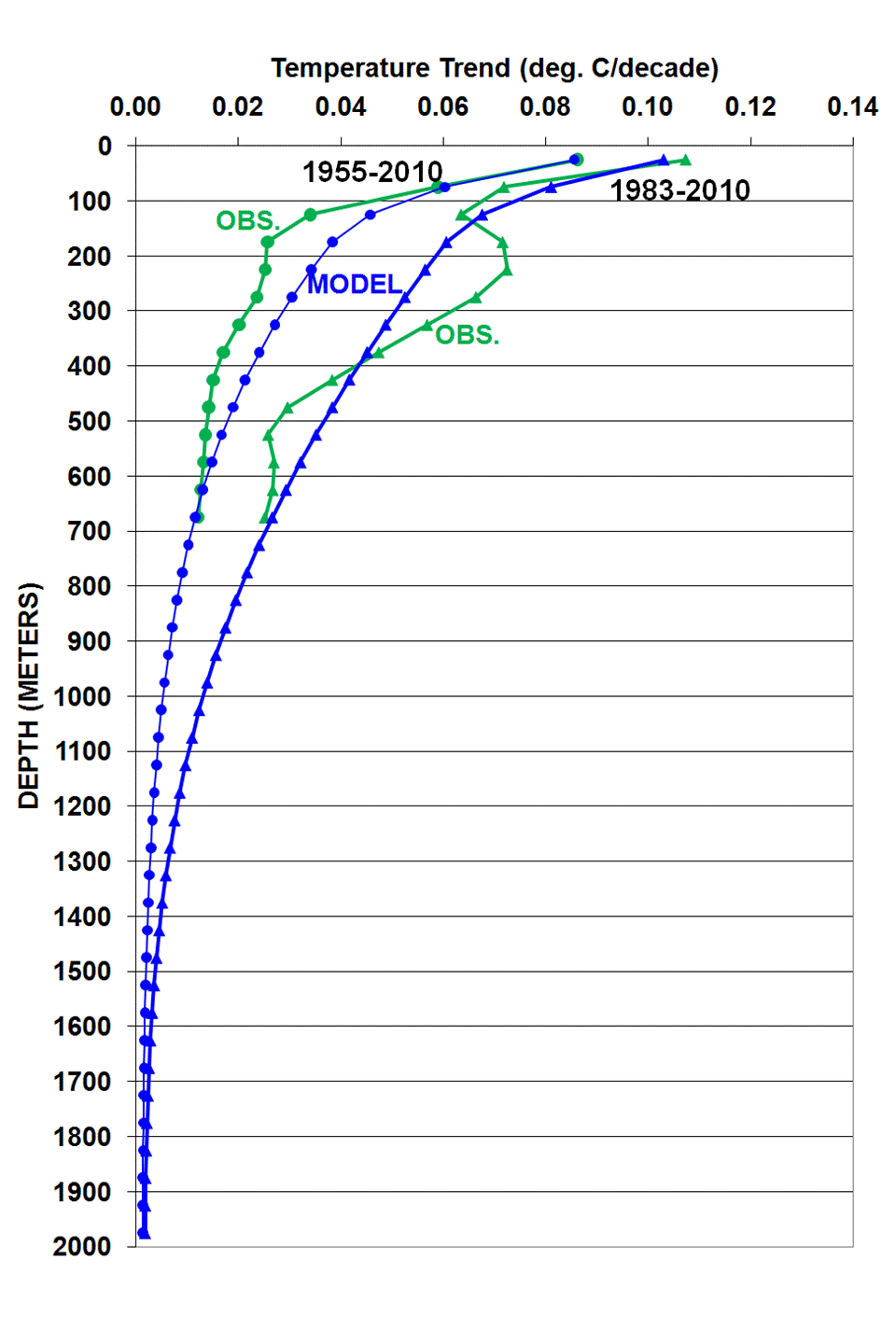The evidence for anthropogenic global warming being a false alarm does not get much more convincing than this, folks.
Using a combination of the GISS-assumed external forcings for long-term temperature changes, and an El Nino/La Nina internal forcing term for year-to-year variability, a simple Forcing-Feedback-Diffusion (FFD) model explains 90% of the variance in ocean heat content variations in the surface-to-50 meter depth layer since 1955 (click for full-size version):

The dashed lines are 3rd order polynomial fits; I have included a small offset between the model and observation data so you can see those trend curves, otherwise they would lie on top of each other. Note that the model captures the lack of warming since about 2003.
Here are the model-vs-observations warming trends as a function of ocean depth; I have plotted them for both the full period (56 years, 1955-2010), and also for the 2nd half of the period (1983-2010) which is when almost all of the warming below 200 meters occurred (click for full-size version):

Now, the important news is that the model fits to the data were accomplished with a climate sensitivity of only 1.1 deg. C for a doubling of CO2 (a feedback parameter of 3.6 W m-2 K-1). This is well below what the IPCC claims for future warming rates.
Also, without the El Nino/La Nina term, the model produces far too much warming late in the period. So, a lack of ocean warming since about 2003 could be La Nina’s ‘canceling out’ CO2 warming. (I found using the Pacific Decadal Oscillation, PDO, as a natural forcing term did basically the same thing, but it could not capture the large El Nino/La Nina temperature swings.)
Of course, there could be other natural forcings at work, too. To the extent that a portion of warming since the 1950s was due to those processes, this would mean climate sensitivity is lower still.
Where’s that Darn Missing Heat?
Now, there are Trenberthian claims out there that a recent lack of warming is due to the ‘missing heat’ hiding in the deep ocean somewhere, just waiting to pounce on us when we aren’t looking. To address this possibility, the model mixes a substantial amount of extra heat down to 2000 meters depth (even though a 2009 Levitus presentation suggested that there has been essentially no warming below 1500 meters depth…see slide 14 here).
In fact, even with low climate sensitivity, the model solution for 1955-2010 pumps 18% more heat into the 0-700 meter layer than the Levitus observations show for that 56 year period. Furthermore, 30% of the total heat pumped into the ocean by the model is below 700 meters deep. So, it appears that even deep ocean heating cannot explain away a recent lack of surface warming.
One of the things you find with these models is that, if the heat cannot mix below the thermocline, then there is no way for the ocean below the thermocline to warm. The Levitus data suggests an average thermocline depth of 100 meters or so….notice the “bend” in the warming profiles around that depth, suggesting resistance to turbulent heat diffusion. Instead, much of the extra heat in the mixed layer is lost to space through negative feedback processes which the IPCC claims are instead positive.
[For a little entertainment, here’s an animation of the three-monthly changes in the temperature profile down to 700 meters, 1955 through early 2011, put together for me by Danny Braswell]:
Levitus temperature profile animation
Conclusion
The bottom line is that the relatively weak warming of the ocean since the 1950s is consistent with negative feedback (low climate sensitivity), not positive feedback. The ocean mixed layer and the atmosphere convectively coupled to it loses excess heat to outer space before it can be mixed into the deep ocean.
In other words, Trenberth’s missing heat is not in the deep ocean…it’s instead lost in outer space.
Model Details:
– 40 model layers, each 50 m thick, to a depth of 2,000 meters (the atmosphere is assumed to be in convective equilibrium with the top layer, and its heat capacity is small enough to be ignored).
– Energy is conserved in each model layer through a combination of forcing, feedback (top layer only), and turbulent heat diffusion between layers.
– Feedback (loss of excess energy to space from implicit changes in the atmosphere with temperature) is proportional to the top layer temperature departure from average.
– Heat diffusion coefficients between layers are manually adjusted to give an approximate fit to the warming profiles with depth. We are working on further optimizing those fits with an iterative adjustment procedure.
– Yearly ‘external’ forcing estimates are from GISS, interpolated to monthly, and extrapolated thru 2010.
– El Nino/La Nina ‘internal’ forcing is empirically derived based upon a best fit to observed year-to-year temperature variations: forcing = 0.85 times the Multivariate ENSO Index (MEI), in Watts per sq. meter, with a time lag of 3 months.
– Model is initialized in 1900 using GISS forcings; MEI forcing is included starting in 1955 (which is when the ocean temperature observations become available for comparison).

 Home/Blog
Home/Blog



